Fermenting Beer with White Labs WLP850 Copenhagen Lager Yeast
Published: September 28, 2025 at 10:27:48 PM UTC
Last updated: November 27, 2025 at 1:29:22 PM UTC
White Labs WLP850 Copenhagen Lager Yeast is a northern European lager strain. It's perfect for brewers aiming for clean, crisp lagers with a subtle malt character. This yeast exhibits 72–78% attenuation, medium flocculation, and can handle medium alcohol levels up to 5–10% ABV. It's sold as a liquid product (Part No. WLP850) and requires careful shipping, mainly in warmer months.
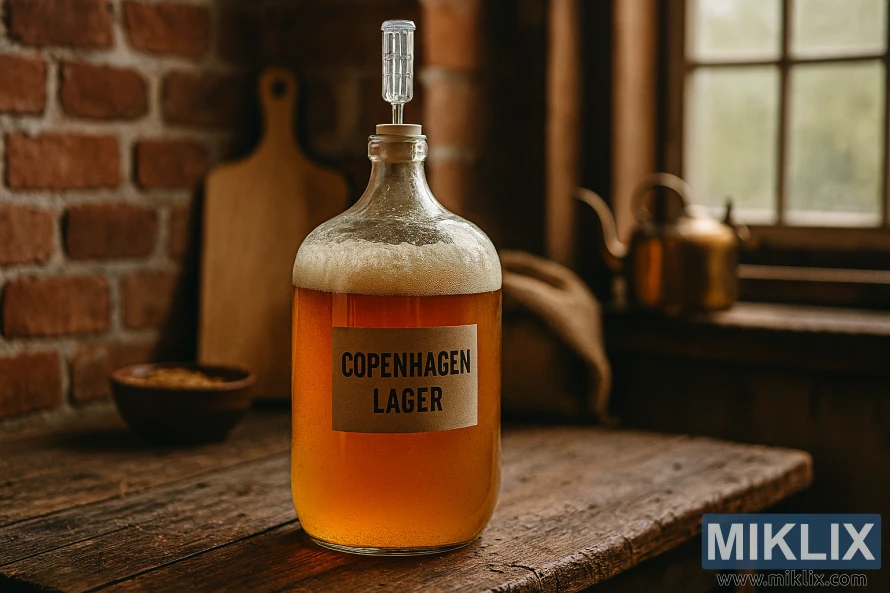
The ideal fermentation range for this strain is 50–58°F (10–14°C). This range supports classic lager profiles, avoiding strong phenolics and esters. It's a favorite for brewing Vienna lagers, schwarzbier, American-style lagers, ambers, and darker lagers. These styles prioritize drinkability over malt forwardness.
This article is a practical guide for home and craft brewers. It covers the technical specs, pitching strategies, temperature control, troubleshooting, and recipe ideas. It aims to help you determine if fermenting WLP850 aligns with your brewing objectives.
Key Takeaways
- White Labs WLP850 Copenhagen Lager Yeast is optimized for clean, highly drinkable lagers.
- Expect 72–78% attenuation and medium flocculation in typical fermentations.
- Ferment between 50–58°F (10–14°C) for best results with this Copenhagen lager yeast.
- Available as liquid yeast from White Labs; ship with thermal protection during warm weather.
- This brewery yeast review focuses on practical steps for home and small craft brewers considering fermenting WLP850.
Overview of White Labs WLP850 Copenhagen Lager Yeast
WLP850 overview: This White Labs strain offers a classic northern European lager character. It excels in delivering a clean, crisp finish, perfect for those who prioritize drinkability over heavy malt flavors. It's ideal for brewers aiming to create sessionable lagers and traditional styles with a restrained malt presence.
Technical details from White Labs strain specs include an attenuation range of 72–78%, medium flocculation, and a medium alcohol tolerance of 5–10% ABV. The recommended fermentation temperature is between 10–14°C (50–58°F). The strain tests STA1 negative, which reduces concerns about diastatic activity.
Suggested styles for WLP850 include Amber Lager, American Lager, Dark Lager, Pale Lager, Schwarzbier, and Vienna Lager. In practice, WLP850 maintains a clean profile in both pale and darker lagers. It preserves subtle malt nuances while keeping the palate bright.
Packaging is in liquid format and comes with a 3 oz ice pack for single vials. White Labs advises using their Thermal Shipping Package for multi-packs or during warm seasons. This helps limit heat exposure during transit.
Market context: WLP850 is part of White Labs’ lager portfolio, alongside strains like WLP800, WLP802, WLP830, and WLP925. Brewers opting for WLP850 typically seek northern European lager profiles. These profiles emphasize clarity and drinkability.
Why Choose White Labs WLP850 Copenhagen Lager Yeast for Your Lager
WLP850 is celebrated for its clean, crisp finish. It allows malt character to shine without being overshadowed by yeast esters. This makes it a top choice for brewers aiming for restraint and drinkability in their lagers.
The benefits of WLP850 include medium attenuation, typically 72–78%. This results in a moderately dry beer, perfect for session lagers. Its medium flocculation ensures solid clarity without sacrificing body, preserving the malt backbone in Vienna and amber lagers.
Many brewers consider it the best yeast for Vienna lager. It enhances toasted and caramel malts while maintaining a neutral fermentation profile. The strain's negative STA1 reduces the risk of over-attenuation from dextrins, ensuring the desired sweetness and balance.
WLP850 is versatile, suitable for a variety of lagers: Vienna, schwarzbier, American lager, amber, pale, and darker styles. This versatility allows one culture to cover multiple recipes, whether in homebrew or small commercial batches.
- Fermentation behavior: reliable attenuation and consistent clarity.
- Alcohol tolerance: covers most lager ABV targets with 5–10% range.
- Availability: sold as commercial liquid yeast by White Labs with standard U.S. distribution.
For brewers considering WLP850, its flavor neutrality, dependable fermentation, and accessibility make it a practical choice. It supports malt-forward lager styles while being flexible for recipe variations.
Understanding Fermentation Parameters for WLP850
WLP850 fermentation parameters aim for a clean lager profile. The target attenuation is 72–78%, indicating how much sugar is converted to alcohol and CO2. This yeast is STA1 negative, meaning it won't break down unfermentable dextrins.
The recommended fermentation temperature for WLP850 is between 10–14°C (50–58°F). This cool range helps minimize phenolic and fruity metabolites, preserving the lager's crispness. Fermentation at these temperatures also results in longer primary times compared to ale yeast.
Attenuation and flocculation specs are key for clarity and conditioning. WLP850 exhibits medium flocculation, leading to a moderate haze. To achieve clarity, consider cold crashing, extended lagering, or filtration for bottle or keg presentation.
Other parameters influence recipe design. The yeast's alcohol tolerance is medium, around 5–10% ABV. This means brewers should plan their malt bills and expected OG to avoid yeast stress. Mash profile and wort oxygenation also impact the strain's expected attenuation and vigor.
- Adjust mash temperatures to control fermentable sugars: lower mash temps raise fermentability, raising possible attenuation.
- Ensure proper wort oxygenation at pitching to support healthy early growth and consistent attenuation.
- Match pitching rate to batch size and OG to maintain clean character and predictable fermentation kinetics.
Quality control is critical for achieving desired outcomes. Viability can decrease during warm transit, so White Labs suggests thermal packaging for shipping. Test viability and plan a starter for older packs or high gravity beers to ensure fermentation performance within WLP850 parameters.
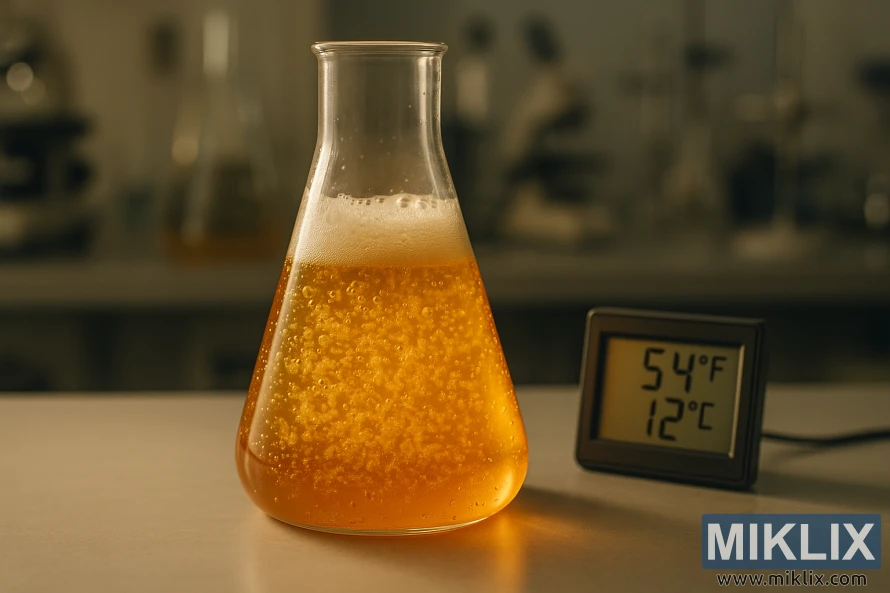
Pitching Rates and Cell Counts for Optimal Results
Start by targeting the right WLP850 pitching rate for your gravity and method. For most lagers, aim near 2.0 million cells per mL per °Plato, which is essential when cooling wort before pitching. This rate helps avoid long lag phases and reduces ester formation in cold fermentations.
For lower gravities up to about 15°Plato, use roughly 1.5 million cells/mL/°Plato. When gravity rises above 15°Plato, increase to about 2.0 million cells/mL/°Plato to support a strong, even fermentation. Cold pitching requires the higher end of these ranges.
If you plan a warm-pitch method, you can reduce the lager pitching cell count. Warming allows healthy growth, so some brewers use about 1.0 million cells/mL/°Plato when pitching warmer. Always monitor fermentation vigor closely when deviating from standard lager rates.
PurePitch Next Generation offers improved glycogen reserves and higher viability than many liquid packs. This means PurePitch vs liquid pitch often allows starting with fewer apparent cells and achieving the desired effective pitching level. Always check vendor specs and treat lab-grown packs differently from standard liquid yeast.
Before you brew, use a yeast pitch calculator. It will convert pack or starter counts into the cells you need for your batch volume and gravity. If you rely on harvested yeast, always measure viability first. Low viability requires a starter or a larger inoculation.
- Repitching guideline: 1.5–2.0 million cells/mL/°Plato is common in professional practice.
- Gravity notes: ~1.5 M for ≤15°Plato; ~2.0 M for >15°Plato.
- Warm pitch: about 1.0 M can work with active growth.
Practical steps: weigh the pack, check vendor viability, and run numbers through a yeast pitch calculator before you brew. When in doubt, make a starter for liquid WLP850 to ensure a clean, full attenuation and a healthy fermentation profile.
Traditional Lager Fermentation Method with WLP850
Start by cooling the wort to 8–12°C (46–54°F) before adding White Labs WLP850 Copenhagen Lager yeast. This temperature is ideal for the yeast's cold tolerance. It ensures a clean, malt-forward flavor profile.
To counteract the yeast's slower activity at these temperatures, use a higher pitch rate. Fermentation will progress steadily over several days. This slow pace helps minimize ester and sulfur byproducts, preserving the lager's classic character.
Once attenuation hits 50–60%, initiate a controlled free rise for a diacetyl rest. Raise the beer to about 18°C (65°F) to allow yeast to reabsorb diacetyl. Keep the beer at this temperature for 2–6 days, depending on how quickly the yeast clears off-flavors.
Once diacetyl levels decrease and terminal gravity is near, cool the beer gradually. Aim for a 2–3°C (4–5°F) drop in temperature each day until it reaches lagering temperatures near 2°C (35°F). This extended cold conditioning clarifies the beer and refines its flavor.
For those planning to repitch, harvest the flocculated yeast at the end of primary fermentation. When brewing Czech-style lagers, ferment at the lower end of the range. Avoid raising the diacetyl rest temperature too high. Condition for longer at similar temperatures to preserve delicate flavors.
- Start fermentation: 8–12°C (46–54°F)
- Diacetyl rest: free rise to ~18°C (65°F) at 50–60% attenuation
- Rest length: 2–6 days depending on yeast activity
- Lagering: cool 2–3°C per day to ~2°C (35°F)
Warm Pitch Method Adapted for WLP850
The warm pitch lager method for WLP850 starts by pitching at the upper cool ale range. This is to jump-start growth, aiming for 15–18°C (60–65°F). This approach reduces lag time and stimulates strong early cell activity.
Look for signs of fermentation within about 12 hours. These signs include visible CO2, krausen, or a small pH drop. Once fermentation is active, lower the temperature slowly to 8–12°C (46–54°F). This supports continued growth while limiting ester formation.
- Start: pitch warm then cooling after activity appears.
- Initial window: first 12–72 hours matter most for ester development.
- Adjust: drop to 8–12°C to restrain off-flavors.
At mid fermentation, perform a diacetyl rest when attenuation reaches roughly 50–60%. Raise the fermenter to about 18°C (65°F) for 2–6 days. This allows yeast to reduce diacetyl efficiently. After the rest, cool steadily by 2–3°C per day down to near 2°C (35°F) for lagering.
Benefits of the warm pitch WLP850 approach include shorter lag times and the possibility of slightly lower pitch rates. This method achieves robust growth. Prompt cooling after the early growth window helps preserve a clean lager profile with restrained esters.
Timing is critical. Most ester formation happens during the first 12–72 hours of growth. Applying the pitching warm then cooling sequence reduces ester carryover. It gives a balance between fermentation speed and flavor control.
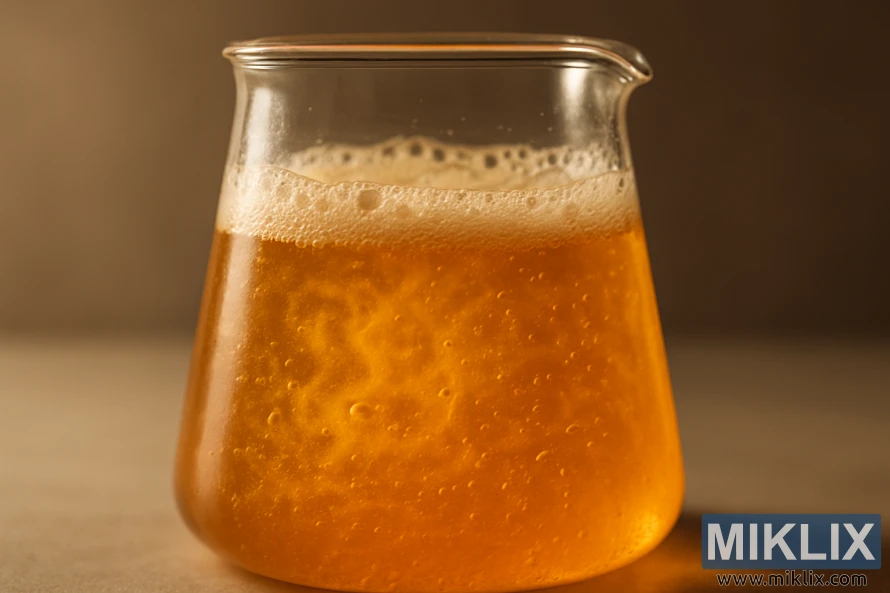
Fast and Alternative Lager Techniques Using WLP850
Many brewers seek lager flavor in less time. Fast lager techniques with WLP850 offer a way to achieve this. This section explores practical options for both home and professional brewers.
The pseudo lager method is a viable option. It involves a warm-start fermentation with controlled attenuation to mimic lager ester profiles. Start with healthy yeast and ferment at 18–20°C (65–68°F). This temperature accelerates fermentation without creating heavy esters, thanks to pressure control.
High pressure lagering can also reduce warm-fermentation off-flavors. By fermenting under pressure, yeast growth is lowered, and certain metabolites are curbed. Set a spunding valve early to capture CO2 and maintain moderate headspace pressure. A starting point of about 1 bar (15 psi) is advisable for initial trials.
Spunding WLP850 requires careful management. Avoid closing the spunding valve until all wort is in the fermenter for double batches. Monitor krausen and gravity closely. Pressure may slow flocculation and clarity, leading to longer settling times after fermentation stops.
- Suggested fast parameters: start fermentation at 18–20°C (65–68°F).
- Set spunding WLP850 to around 1 bar (15 psi) for warm, controlled activity.
- After terminal gravity, cool gradually 2–3°C per day down to ~2°C (35°F) for lagering.
Before pushing WLP850 into extreme fast methods, consider strain traits. WLP850 is designed for cooler profiles and may not clear as quickly under pressure. If crystal-clear beer is essential, test a more flocculent lager strain on a small batch first.
Scaling up requires careful consideration. Beer fermented under pressure often needs more time to clear. Balance the speed gains against traditional flavor fidelity. Keep detailed records to compare pseudo lager trials with classic cool ferm using WLP850.
Preparing Starters and Using PurePitch vs Liquid WLP850
Upon arrival, inspect the yeast pack. White Labs ships liquid yeast chilled, but it may be affected by heat or long transit times. For lagers and beers with an ABV over 5%, a viability check and a WLP850 starter are essential. They help ensure you reach the desired cell count.
Consider building a starter if packet cell counts seem low or for brewing high-gravity wort. Sanitize your equipment, create a 1.030–1.040 gravity wort, oxygenate it gently, and monitor its growth. This process typically takes 24–48 hours, resulting in a healthy cell count for cold-pitched fermentations.
Before choosing between PurePitch and liquid yeast, understand their differences. PurePitch Next Generation vials often have more consistent viability and higher glycogen reserves. Brewers can pitch lower volumes of PurePitch, following vendor guidelines. Use a pitch calculator to confirm the appropriate rates.
When deciding on starter size or pack count, use industry pitch targets. For lager yeast, aim for 1.5–2.0 million cells per mL per °Plato. Online pitch calculators can help convert your batch size and wort gravity into a recommended starter volume or pack count.
Be prepared for summer shipping. If the yeast has been exposed to heat, increase the starter size or create a two-step starter to recover its vigor. For reliable results, document the starter volume, estimated cell count, and the timing relative to your planned cold pitch.
- Quick starter checklist: sanitized flask, 1.030–1.040 starter wort, gentle oxygenation, room temp fermentation 24–48 hours.
- When to skip a starter: using fresh PurePitch with vendor-confirmed viability and low-gravity wort where recommended pitch rates are met.
- When to scale up: brewing high-gravity lagers, extended shelf transit, or visible pack degradation.
Keep a record of each batch's outcome. Tracking starter size, pitch method, and fermentation results will help refine your approach. This will make future decisions about WLP850 starter needs and the choice between PurePitch and liquid yeast clearer and more predictable.
Wort and Mash Considerations for Best Results with WLP850
To align with your beer style, set the mash temperature between 148–154°F (64–68°C). A cooler mash, around 148–150°F (64–66°C), enhances fermentability and dries out the finish. On the other hand, a warmer mash, closer to 152–154°F (67–68°C), retains more dextrins, leading to a fuller body.
Design a lager mash schedule that aligns with your fermentation goals and equipment capabilities. Single-infusion mashes are often sufficient, but step mashes can be beneficial for high adjunct bills. Ensure the saccharification rest is long enough for complete conversion, which is critical when using under-modified malts.
To control the wort composition WLP850, aim for a grain bill that supports 72–78% attenuation. For beers with original gravities above 15°Plato, increase the pitch rate and prepare a larger starter. This is essential for yeast to handle high gravity fermentation effectively.
Thoroughly oxygenate the wort before pitching. Adequate oxygenation WLP850 is vital for biomass growth in the early stages of fermentation. This is even more critical for cold lager ferments and when using high pitch rates.
- Use quality Pilsner and Vienna malts to showcase the clean yeast character.
- Limit strong adjuncts and assertive hops so the lager base remains balanced.
- Adjust mash thickness to influence fermentability and mouthfeel.
Match the lautering and clarity steps to WLP850’s medium flocculation. Incorporate Irish moss in the boil, ensure a calm whirlpool, and perform a cold crash to enhance clarity. Fining agents and a gentle lagering period will further settle yeast and proteins, resulting in a clear pour.
Keep an eye on gravity progression and taste samples during conditioning. Adjust the mash profile WLP850 and wort composition WLP850 across batches to achieve consistent results with your chosen lager mash schedule.
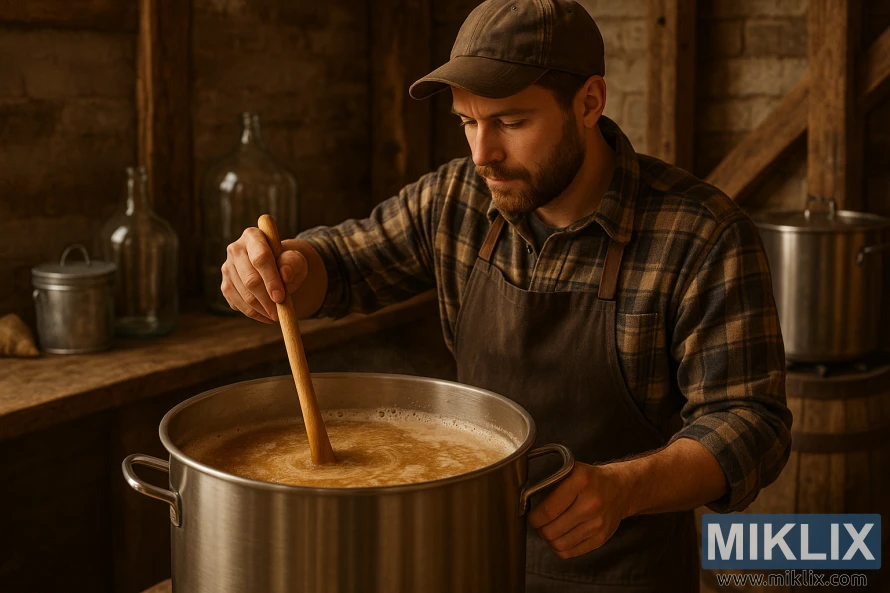
Temperature Control and Fermentation Timeline
Begin primary fermentation at the recommended 10–14°C (50–58°F) range. A stable start aids yeast in following a predictable timeline. Monitor specific gravity daily until fermentation activity is evident.
Cold-pitching slows down the process. The WLP850 fermentation timeline often includes quiet days before kraeusen forms and attenuation increases. Be patient, as rushing the fermentation can harm the beer's quality.
Follow the lager fermentation schedule for a diacetyl rest. Raise the temperature by 2–4°C (4–7°F) when attenuation hits 50–60%. This step allows yeast to reabsorb diacetyl and clean up byproducts.
During the diacetyl rest, use gentle temperature ramps with the WLP850. Avoid sudden temperature changes, as they can stress yeast and introduce off-flavors. Gradual temperature increases keep yeast healthy and active.
- Primary fermentation: 10–14°C until most attenuation occurs.
- Diacetyl rest: raise 2–4°C at ~50–60% attenuation for 2–6 days.
- Crash cool: drop 2–3°C per day toward lagering temperature near 2°C (35°F).
After the rest, start a controlled cool-down. Cool at 2–3°C (4–5°F) per day to avoid yeast shock. Aim for a conditioning temperature around 2°C for clarity and flavor enhancement.
Conditioning times vary by style. Some lagers may improve in weeks, while others benefit from months of cold lagering. Use gravity readings and taste to determine packaging readiness.
Keep an eye on gravity and visible signs of fermentation throughout. A consistent lager fermentation schedule and careful temperature management with WLP850 minimize yeast stress. This approach reduces the risk of off-flavors in the final product.
Managing Off-Flavors and Troubleshooting with WLP850
WLP850 can produce diacetyl, higher esters, and sulfur compounds. These issues often stem from incorrect pitch rates, oxygen levels, or temperature control. Monitoring fermentation speed and aroma early is key to identifying problems quickly.
Preventive measures are more effective. Ensure healthy yeast is pitched at the correct rate, provide sufficient oxygen, and maintain the proper temperature range for WLP850. Protecting yeast from heat during transport and storage is also vital to maintain viability.
Effective diacetyl management requires a strategic approach. Perform a diacetyl rest by increasing the temperature to around 18°C (65°F) when attenuation reaches 50–60%. Hold this temperature for two to six days. This allows the yeast to reabsorb diacetyl, aiding in its management.
To control esters, limit warm fermentation during the growth phase. If using a warm-pitch method, reduce the temperature after the initial 12–72 hours. This helps manage fruity esters and ensures the strain's quality.
- Slow fermentation can signal low viability or a low pitch rate.
- Make a starter or gently warm the fermenter if activity is sluggish.
- Persistent off-flavors may improve with extended conditioning and cold lagering.
When troubleshooting lager fermentation, first assess yeast health, then check oxygen, temperature, and sanitation levels. Monitor gravity to track progress and compare it to expected attenuation for WLP850.
For long-term quality, keep detailed records of each batch. Adjust the process for future brews based on these records. Proper pitching, oxygenation, and a timely diacetyl rest are essential for managing diacetyl and minimizing off-flavors in WLP850 brews.
Flocculation, Harvesting, and Repitching Practices
WLP850 flocculation is classified as medium, meaning yeast settles at a steady pace. This results in a reasonably clear beer after conditioning. For very bright results, extra time or filtration might be needed. This settling behavior makes harvesting practical for most brewery setups.
To harvest WLP850, cool the fermenter and let the trub and yeast settle. Work under sanitary conditions and transfer yeast carefully to sanitized vessels. If your protocol calls for yeast washing, use chilled, sterile water to reduce trub and hop debris while preserving yeast vitality.
Before repitching WLP850, assess cell viability and vitality with a methylene blue or propidium iodide stain. Count cells using a hemocytometer or automated counter. Adjust pitch rates to match lager standards: aim for about 1.5–2.0 million cells per mL per °Plato for repitches. This maintains consistent attenuation and fermentation speed.
- Record generation count and fermentation performance for each harvest.
- Limit generations to retain genetic stability and reduce stress.
- Watch for signs of contamination, reduced attenuation, or flavor drift.
Store harvested yeast cool and oxygen-limited if short term. For longer storage, follow industry best practices for refrigeration. Avoid freezing without cryoprotectants. Regularly test harvested yeast for viability before use in production.
Because WLP850 flocculation sits in the middle range, reuse is often worthwhile for small breweries and homebrewers. Always check viability and pitch appropriately when you harvest WLP850 to repitch WLP850 reliably across batches.
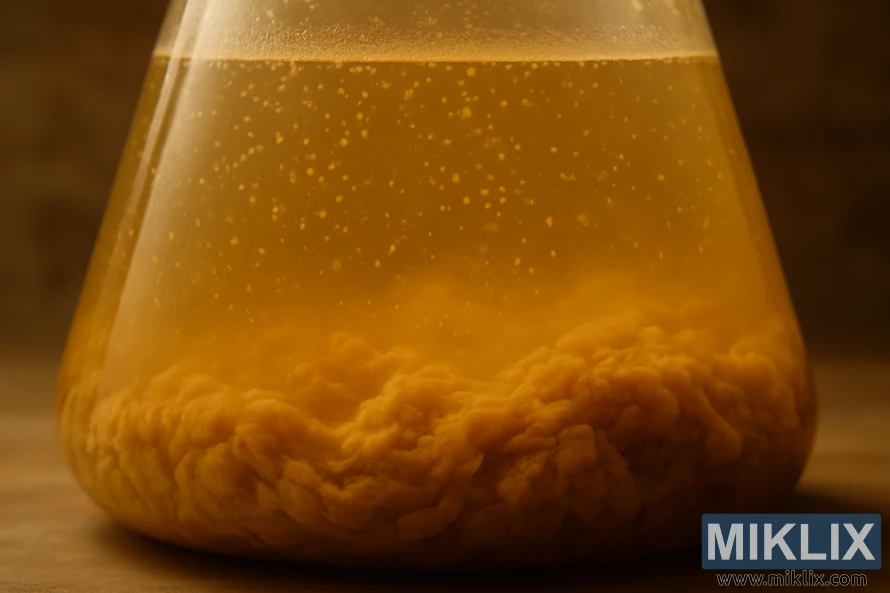
Packaging, Lagering, and Conditioning Recommendations
Only package your beer once it has reached a stable terminal gravity and after undergoing cold conditioning. The best results from WLP850 packaging occur when metabolites have decreased and yeast activity is minimal. It's essential to check gravity readings over consecutive days before transferring to keg or bottle.
Gradually cool the beer to about 2°C (35°F) for lagering WLP850. This slow cooling process aids yeast settling and minimizes chill haze risk. Extended cold conditioning enhances clarity and smooths out harsh esters.
The lagering time varies by style. Light lagers might require a few weeks at near-freezing temperatures. On the other hand, robust, full-bodied lagers often benefit from several months of cold conditioning to develop their depth and polish.
Decide between kegging or bottle conditioning based on your distribution and serving needs. When bottle conditioning, ensure yeast health and residual fermentables for reliable carbonation. For kegging, set CO2 levels according to the style.
- Cold crashing and time are simple clarity aids.
- Finings like gelatin or isinglass speed up brightening when needed.
- Filtration gives instant clarity but removes yeast for bottle conditioning.
Given WLP850's medium flocculation, combining methods yields the best results. A short cold crash before packaging helps settle suspended particles. Use finings sparingly to avoid stripping the delicate lager character.
For conditioning recommendations, adjust carbonation based on the beer style and serving temperature. Use 2.2–2.8 volumes CO2 for many lagers. Adjust higher for German pilsners or lower for darker, cellar-style lagers.
Proper storage in cold temperatures is key to maintaining the beer's quality. White Labs emphasizes the importance of thermal protection for live yeast shipments. For finished beer, cold storage after packaging preserves hop notes, malt balance, and the clean profile achieved during lagering WLP850.
Keep an eye on packaged beer for off-odors or over-attenuation. If bottle conditioning stalls, warm the bottles slightly to revive yeast activity. Then, return them to cold storage once carbonation is complete. Proper timing and handling ensure a bright, clean lager ready for serving.
Suggested Styles and Recipe Ideas Using WLP850
White Labs suggests Amber Lager, American Lager, Dark Lager, Pale Lager, Schwarzbier, and Vienna Lager as perfect matches for WLP850. These styles highlight its clean, crisp profile and medium attenuation. Use them as a starting point for your WLP850 recipe ideas.
Creating a Vienna lager recipe with WLP850 starts with a grain bill of Vienna and Munich malts. Mash at 150–152°F (66–67°C) to achieve a balance between body and fermentability. Choose an original gravity that allows WLP850 to reach the desired final gravity without overworking the yeast.
For a schwarzbier with WLP850, focus on darker specialty malts in moderation. Add Carafa or roasted barley in small amounts for color and gentle roast notes. Avoid harsh astringency. Keep the OG moderate and ferment within WLP850’s recommended temperature range for a clean dark lager.
In brewing American, pale, or amber lagers with WLP850, aim for a crisp malt backbone and restrained hop profiles. Lower mash temperatures result in a drier finish, highlighting the yeast’s clean character. Use Pilsner or light Munich base malts with small additions of caramel or Vienna for added complexity.
- Adjust mash temp by style: 148–150°F for drier lagers, 150–152°F for more body.
- Scale pitching: use a starter or multiple PurePitch packs for higher gravities.
- Follow a diacetyl rest near the end of fermentation, then lager cold for several weeks.
Practical tips: step up starters for big beers and ensure adequate oxygenation at pitch. Match mash and pitch strategies to gravity and timeline. These choices enable WLP850 recipe ideas to succeed across light and dark lager styles.
Conclusion
White Labs WLP850 Copenhagen Lager Yeast is a reliable choice for a variety of lagers. It offers a clean, crisp profile, making it perfect for beers fermented between 50–58°F (10–14°C). This strain is ideal for Vienna, schwarzbier, American-style lagers, and other pale to dark lagers. It's known for its restrained yeast character.
To brew successfully with WLP850, follow key steps. Respect the pitching rates and consider using a starter or PurePitch for cold pitches. A diacetyl rest and proper temperature control are essential. Also, allow enough lagering time to enhance clarity and flavor.
When using liquid WLP850, ensure it's properly packaged for shipping. Verify its viability before brewing to prevent fermentation problems. In summary, this yeast is a solid choice for those looking for a clean, consistent lager. It's a favorite among U.S. homebrewers and craft brewers for its predictability and clean finish.
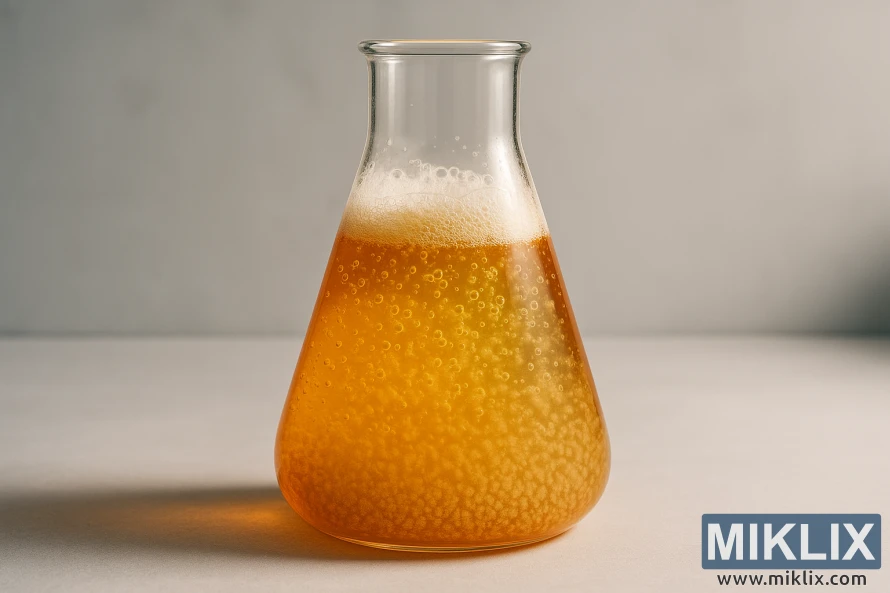
Further Reading
If you enjoyed this post, you may also like these suggestions:
- Fermenting Beer with Lallemand Sourvisiae Yeast
- Fermenting Beer with Bulldog B16 Belgian Saison Yeast
- Fermenting Beer with Bulldog B44 European Ale Yeast
